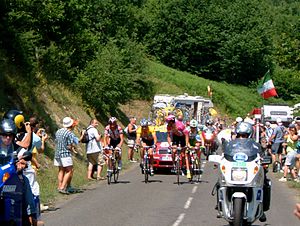 Image via Wikipedia
Image via WikipediaPublished: July 3, 2010
ROTTERDAM, the Netherlands — In the toughest, most varied Tour de France in recent history, the 198 riders do not have to be the best in every stage to pedal into Paris on July 25. But they do have to survive the hard days. There are plenty of them in this year’s Tour.
Here are a few stages that will excite some riders and challenge others — and make for must-watch cycling:
Stage 1
Sunday, Rotterdam to Brussels, 138.9 miles
If the riders were not already nervous to start this 21-day race, Stage 1 will give them a reason to fret. The peloton will head right into one of the trickiest stages of the Tour after Saturday’s prologue in Rotterdam. What will cause the trouble are the unpredictable crosswinds as the course hugs the North Sea. The riders will traverse bridges and ride past tens of thousands of raucous spectators along the way. A similar stage of this year’s Giro d’Italia, one of cycling’s other Grand Tours, resulted in the mayhem of riders crashing left and right. During this stage, big pileups will also be a possibility.
The top riders must also be on the lookout for possible splits in the peloton. Alberto Contador will probably be on guard at all times after crosswinds in one stage of last year’s Tour caused the peloton to split. The front-running riders took off, leaving Contador and others behind.
Stage 3
Tuesday, Wanze, Belgium, to Arenberg Porte du Hainaut, France, 132.3 miles
Among riders and team officials, this is the most talked-about stage of the 2010 Tour, hands down. After Lance Armstrong checked out the stage route, he posted this on his Twitter account: “Going. To. Be. Carnage.”
This stage features 7 sections and 8.2 miles of rough, bone-rattling cobblestones. To say the least, that has made some of the race favorites uneasy. They know what could happen — and fear it. The last time cobblestones were included in the Tour was in 2004. One of the race favorites, Iban Mayo, crashed before one cobblestone section, ending his Tour hopes. Other times, riders have hit the pavement on the cobblestones, breaking collarbones, arms and even legs.
Riders who succeed on this terrain are able to manhandle their bike as it rattles over the bumps — but must also be race savvy. Top riders need to be near the front as the pack hits the cobblestone sections, lest they end up at the back of the pack, possibly minutes back. Those bumpy roads are often narrow, so riders caught unaware could find themselves at the end of a long train as the pack hits the cobblestones and is strung out into a line of riders that seems miles long. The fight to be at the front causes many of the crashes, with riders doing anything and everything to stay at the head of the race.
Stage 8
Next Sunday, Station des Rousses to Morzine-Avoriaz, 117.4 miles
This is where Contador and the other climbers will begin to show their stuff — if they make it out of the first week in one piece, that is. As the race heads into the high Alps, this is where the tough climbing begins. Recognize the town Morzine? It is where Floyd Landis ended his improbable solo ride over several Alpine passes during the 2006 Tour. (He was stripped of that Tour title for doping.) This time, there will be two particularly tough climbs that are rated Category 1, which is one level below a race’s most difficult climbs. The finish line will come at Morzine-Avoriaz, which is more than 5,892 feet above sea level.
Stage 17
July 22, Pau to Col du Tourmalet, 108.1 miles
This stage comes just after the riders’ final rest day. And, considering how difficult and decisive this stage is likely to be, they will have needed that rest.
Two Category 1 climbs come before the daunting hors-category (the highest category there is, saved for the most difficult climbs) Tourmalet, which encompasses about 11.5 miles of ascending with an average 7 percent grade. As the riders fight for the top, lungs and legs will burn. If the overall leaders are close in the standings, this is where they will clinch the victory — or lose it. The dramatic stage ends atop Tourmalet, which is so high it could cause nosebleeds — 6,939 feet above sea level.
A version of this article appeared in print on July 4, 2010, on page SP8 of the National edition.



No comments:
Post a Comment